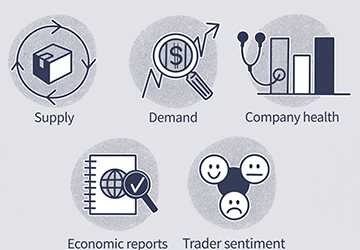3 Ways to Balance Growth Stocks and Stability
The real trick to long-term success in the investment world is finding that sweet spot between growth stocks and stability. Growth stocks offer the potential for good capital appreciation but come with increased investment risk.
Stable investments provide the bedrock for mitigating your portfolio's volatility and preserving wealth. By judiciously balancing these two elements, you can devise a strategy for achieving your financial objectives while granting peace of mind.

A balanced portfolio will help you navigate the markets' unmatched uncertainty, lower risk, and boost your return.
In this blog post, we'll explore three ways to balance growth stocks and stability in your investment portfolio. Apply these strategies to build a strong wealth investment plan. Keep reading to learn ways to optimize your portfolio for long-term performance.
Why Balancing Growth and Stability is Crucial?
Long-term investment success depends on achieving the proper mix of growth stocks and stable investments and diversifying the portfolio levels out most market-related risks and economic uncertainties.
This way, the portfolio will be constructed to survive the market's inevitable downturns and grow even further. Adding more stable investments like bonds or dividend-bearing stocks often flattens the growth curve.
They need to be a part of a balanced portfolio to raise a steady income stream and level out the overall portfolio's volatility. Such investments provide an income stream, levelling the portfolio's overall volatility.
Contrast that with growth stocks, which tend to promise substantial gains and, when it comes to this element, are therefore crucial in pursuing long-term financial goals.
Get the balance between growth and stability right, and you'll have the best of both worlds: a shot at high returns in safekeeping that holds up a solid foundation. That may sound challenging, but the payoffs are worth the effort.
3 Ways to Balance Growth Stocks and Stability
With this background on why growth stocks and stability must be balanced, let's look at three strategies for balancing an investment portfolio.
Way 1. Diversify Your Portfolio
One of the best ways to seek a balance between growth and stability is through diversification. Spreading the investment across classes of assets reduces the overall risk associated with that portfolio. To do this, include a mix of growth stocks, stable blue chip stocks, bonds, and other assets.
● Invest in a combination of high-growth stocks and solid, stable dividend payers to find a balance between potential returns and risk.
● Improve your portfolio diversification through an allocation to bonds or fixed securities that provide steady income and cushion against the market's volatility.
● Diversify the investments further across the portfolio, considering other alternative investment options in real estate, commodities, and the like that are less correlated to equities and bonds.
Way 2. Set Clear Investment Goals
Clear and realistic investment goals are crucial in balancing a good investment portfolio. Delineating your short—and long-term objectives will enable you to properly proportion assets between growth and stability.
● Identify your risk tolerance and time horizon to make your investment strategy appropriate for your financial situation and goals.
● When investing for long-term goals, like retirement, put more significant portions of your portfolio into growth stocks, which have historically provided better returns.
● Ensure that stable investments, such as bonds or dividend-paying stocks, are at the top. These investments fulfil short-term needs or generate a reliable income stream.
Way 3. Regularly Rebalance Your Portfolio
Fluctuations that lie ahead in the marketplace can push your portfolio off the balance of growth and stability for which you are striving.

Regularly reviewing and rebalancing your portfolio ensures that your investments suit your goals and risk tolerance.
● You should review your portfolio at least once a year to assess its performance and any reorganizing that may be required.
● Rebalancing the portfolio involves selling overperforming assets and using these funds to reinvest in underperforming ones, maintaining the original mix between growth and stability. Regular rebalancing helps minimize risks, lock in gains, and support diversification in the portfolio in line with your investment strategy.
Achieve Investment Balance Today!
These are essential techniques to teach: Balancing growth stocks with stability over the long run is the key to successful investing. Refrain from being caught flat-footed when building more strength and delivering higher returns in your portfolio.
Diversify now, set clear objectives for yourself, and rebalance your holdings continuously and consistently. Those early investors who have applied these techniques are already reaping the rewards of a well-balanced approach.
Do not let market jitters catch you by surprise. Enhance your portfolio now and have peace of mind with proper, stable, growth-oriented strategies.
Frequently Asked Questions
Q. How can I develop the right mix of growth and stable investments in my portfolio?
Ans. All that depends on your risk tolerance, investment goals, and time horizon. In most cases, a younger investor can tolerate a more growth-based portfolio, while the investor near retirement should lean toward more stable investments. Consult your investment professional for specific recommendations.
Q. What are some examples of GIC-stable investments?
Ans. Examples include bonds, dividend-paying stocks, or real estate investment trusts, likely to provide dampened volatility but steady income versus growth stocks and balance risk within your portfolio.
Q. How often should I rebalance my investment portfolio?
Ans. You should check and rebalance your portfolio on an annual basis. However, it would help to rebalance more often than that should your portfolio drift too far from the target allocation because of market movements.





